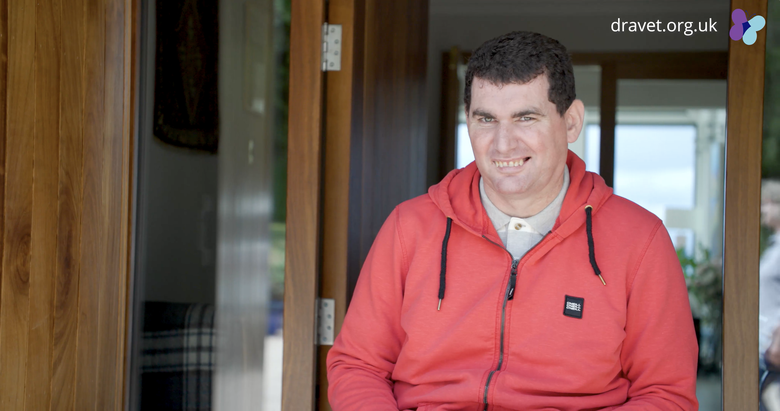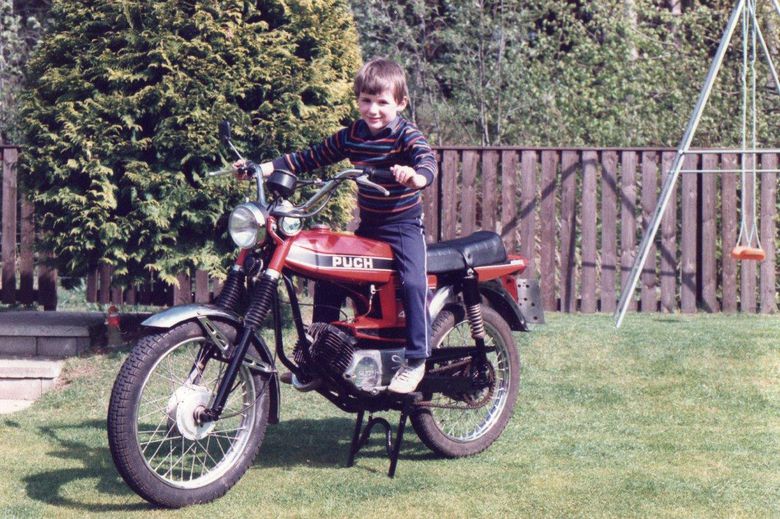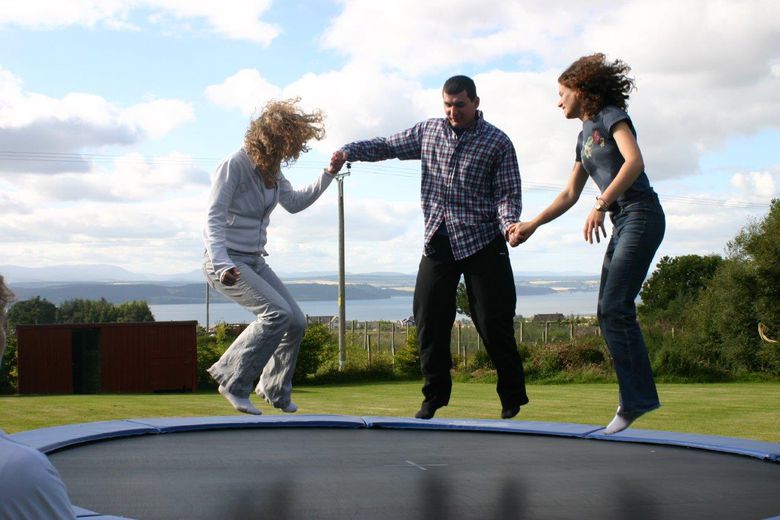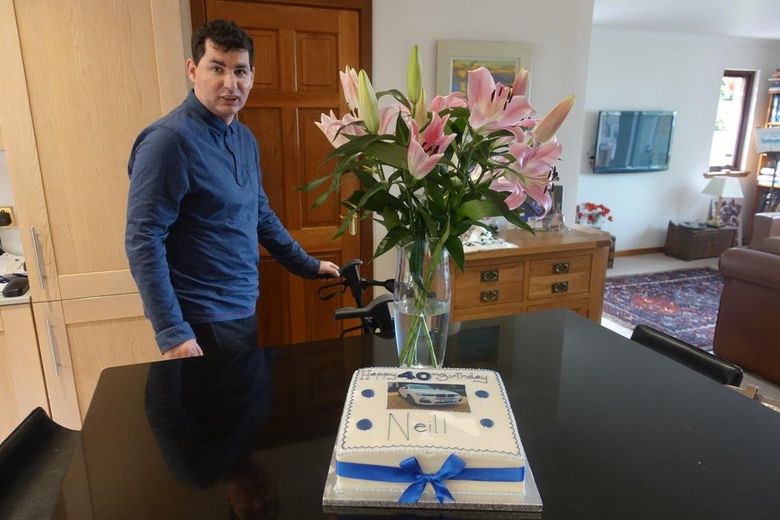Neil
Neil is 42 years old and living with Dravet Syndrome. He is part of a loving family, based near Inverness in Scotland. His Dravet diagnosis came later in life, when he was 36 years old, and this led to many improvements in seizure control and quality of life. Neil lives for part of the year in supported living, and comes home regularly to his parents for holidays.
Neil today
Gordon, Neil’s father says: "Our son Neil is 42 years old, good fun to be around, loving with a happy personality, however medically very challenging and still in need of 24/7 care.
Neil is the second of 4 now adult children, brother to 2 sisters and 1 brother and uncle to 4 nieces and 2 nephews. All his siblings have over the years been very supportive of Neil and while Neil lived at home for 15 years, they often had to compromise on things they might have wanted to do or places they wanted to go as Neil’s condition often dictated our family routines. In spite of this they seemed naturally to understand. This was in part due to how we agreed to bring Neil up as normally as possible within the family.
Neil just loves his family and they him, particularly the grandchildren who are actually disappointed if Uncle Neil is not at home when they visit us! They contact him using FaceTime and Zoom and he remembers them all and can say their names. When Neil comes home for holidays, 4 times a year, it usually includes an overnight stay with his sisters. He also loves nothing better, apart from going in a car, than browsing through his photo albums with all up to date photos of his family. It is very interesting to note that whilst Neil has limited speech his memory is quite amazing and his understanding is very good indeed.
In the early days Neil’s attention span was very limited but now he can enjoy a film at home or at the cinema. We had no hesitation in taking Neil to Majorca two years ago for a lovely week in a villa with a pool, to celebrate his 40th birthday. This is something we simply could not even contemplate doing when he was younger".
Neil’s early years
Neil, a healthy and beautiful baby, had his first seizure when he was 3 months old, a lengthy tonic-clonic seizure lasting approximately 40 minutes, which required an emergency night time visit to hospital. This was to become the pattern for years, frequent prolonged seizures, stays in hospital, referrals to larger hospitals with epilepsy specialists, tests and more tests and cocktails of various epilepsy medications tried. Neil was diagnosed as a child with generalised epilepsy.
Teenage years
Neil lived at home with us and he attended special school until he was 15 years old. His seizures remained frequent, his learning was poor and speech limited although he loved to sing and could remember and sing a whole verse of a familiar song but could not speak a sentence! Throughout his early years things could be very difficult. Neil was hyperactive, often inducing a seizure, and we certainly know where the saying “you need eyes at the back of your head came from”. When Neil was 15 years old, we were faced with the realisation when his head teacher told us they were finding it extremely difficult to manage Neil’s condition.
This in turn led to a referral to David Lewis, an organisation in Cheshire, specialising in epilepsy and related problems. We knew we would miss Neil terribly however we knew a decision had to be made as to best steps for his future.
It was agreed Neil would have a residential school term placement. This led on to a full-time placement when he was 19 years. Neil has had very good support from his local authority and NHS Highland allowing his placement to continue. There were times the authority wanted to explore placements nearer home however Neil has remained at David Lewis as this was seen as the best place to continue to meet his changing needs. The distance between us has been difficult and transporting back and fore not easy at times. Thank heavens now for Facetime and Zoom.
Throughout this time Neil’s seizure pattern fluctuated but generally he continued to suffer tonic-clonic seizures regularly and rescue medication was required. Neil’s outwardly loving personality has helped us greatly to minimise the enormous stress suffered over the years when his seizures were at their worst. As the years have gone by and Neil’s seizures better controlled, Neil himself appears more settled.
Diagnosing Dravet Syndrome
We were constantly reading up on epilepsy to try to identify a cause. We had spoken with Neil’s neurologist, as to whether Neil’s condition was hereditary as his siblings were likely to want to have children. Through our research we were almost sure Neil had Dravet Syndrome.
Neil’s neurologist agreed to refer Neil for genetic testing at Centre for Genomic Medicine, St Marys, Manchester so the process begun in 2013. From the initial test there was no conclusion. The following year we received a letter asking for permission to carry out further tests. Neil was subsequently given a clinical diagnosis of Dravet Syndrome in 2014. He was 36 years old. This concluded in ourselves being tested, confirming Neil had a mutation in the SCN1A gene de novo. This came as a great relief, not just for directing what drugs to use but also Neil’s diagnosis showed his condition was not hereditary. Neil’s brother and sisters were very grateful for this as by this time they had all had children of their own and this took away worries they may have had of their children inheriting Neil’s particular condition.
Our biggest regret was not having a diagnosis of Dravet Syndrome sooner which would then have allowed us to target specific drugs identified specifically for Dravet. In the past Neil had had so many trials of different drugs, some contraindicative to Dravet treatment. Over time we had always found Neil had responded well to topiramate and clobazam. Having an earlier diagnosis would also have given us the benefit of the support and the knowledge from Dravet Syndrome UK.
Benefits of diagnosis, even later in life
Neil continues to have tonic-clonic seizures although latterly less frequent. He however has increased problems with pre-ictal activity, mainly on waking. This can go on for at least 40 minutes and needs constant supervision throughout this time. It can develop into tonic-clonic.
One of the major benefits of better, more targeted drugs as a result of genetic testing is that when Neil is having less seizures his ability to learn more has increased. He is now pretty good with colour recognition, remembering parts of songs, new words and happy to do jigsaws. All a recent big improvement.
Earlier this year Neil actually went just over 10 weeks seizure free, the best he has ever been and unimaginable, prior to this usually every 2 to 4 weeks, sometimes even less. The pre-ictal activity in the morning has also improved due to a small increase of clobazam on waking.
Life as an adult with Dravet Syndrome
Over recent years, Neil has experienced some ups and downs. Following a bad fall, when Neil accidentally tripped and hit the ground awkwardly in 2016, he had to have a full knee replacement. There has been subsequent nerve damage and a further fall caused by a seizure led to a break in the ankle. Neil now has poor mobility and mainly uses his wheelchair. He has borderline osteoporosis and has recently had kidney stones removed. This caused undue anxiety for us and staff as it was only when Neil became seriously ill, we were aware it was kidney stones to blame. This is the downside of Neil being unable to tell us if anything is wrong. The kidney stones were analysed and confirmed his epilepsy medication had not contributed to the stones.
Neil had a follow up clinic in February this year and this time ‘refused’ to go into the CT scanner. Neil’s consultant was superb. He then arranged for the scan to be done under general anaesthetic and was quickly wheeled to the theatre to have some further ‘shattered’ stones removed. We also took advantage of this to have the dentist check his teeth under general anaesthetic as Neil can be reluctant to allow routine dental examination. Neil required 3 extractions and two fillings which came as a shock and highlighted the need for a complete regular dental care plan to be in place.
In spite of everything Neil never complains and is always pleased to see us. His main love, as mentioned earlier, is getting out in the car. We have recently purchased a lovely modern red, his favourite colour, wheelchair for Neil. With the help of the 16 plus grant we were fortunate, in addition, to purchase all terrain wheels for the chair which we are very grateful to Dravet Syndrome UK for. This will enable Neil to get out and about in the Highlands with us on our long country walks.
When it was first suggested some years ago that Neil be moved out of the main centre, we did have concerns about the safety issues as Neil had little road sense. However, this proved a good move, and Neil is now very happy in a small care home, wheelchair friendly, situated in the community with 3 other residents receiving 24/7 care. This is run by David Lewis and offers a much more family environment for Neil and he gets out and about more in the community with caring staff.
Looking to the future
The future for Neil now is to see what further procedures can be done to improve his damaged ankle and failing this what better orthotic support can be put in place. We are encouraged to know new drug research is ongoing and hopefully might help minimise Neil’s seizures further in the future.
We continue to be amazed how good natured and happy Neil is despite 42 years of numerous drug regimes and many intractable seizures. The future now looks good if he continues to improve as he is doing.
Neil loves coming home and as far as we can gather he is able to understand he has two happy homes, so we can ask for little more."



